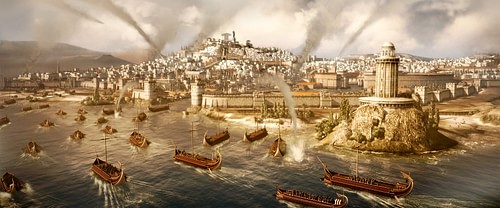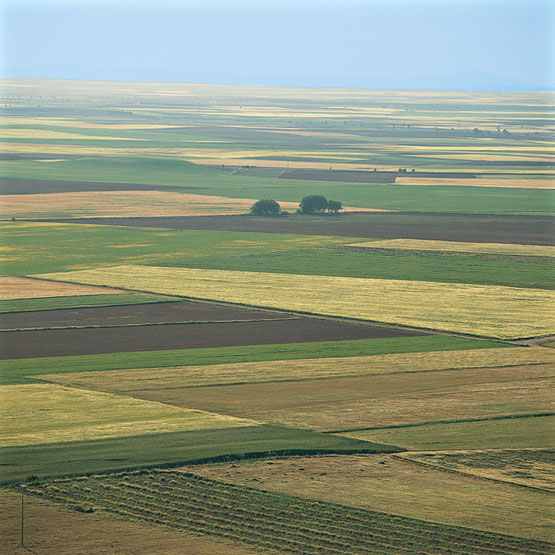The Iberian Peninsula had been seized by various Germanic tribes- at first, it were the Vandals and the Suebi, who had made themselves at home; later, they had been displaced by the incoming advancing Visigoths. The Visigoths were an East Germanic people, who at first settled in Aquitaine, in the valley of the Garonne, centerred around the city of Tolosa (1). From there, they were pushed away away by the advancing Franks. Thus, the Visigoths took over Spain, moving their capital to Toletum (2).
The Germanic Arian horsepeople formed the new aristocracy of the realm, ruling over a Catholic urban and rural Hispano-Romance populace. In the beginning of the 8th century, Visigothic Spain was in much a different shape than two centuries earlier. Due to legal and religious unity, the Visigoths by now had mostly been assimilated into the Hispano-Roman society. The largest density of Visigothic settlements could have been found in places like Tierra de Campos near the town of Palencia. Other settlements occured near the Tagus (3) estuary, at the upper reaches of the Duero, and around the cities of Mérida and Toletum.
(Tierra de Campos)
The Tierra Campos maintained its Visigothic identity long after other Visigothi communities were assimilated. The ethnic enclave near Palencia became a formidable cavalry sourcefor the country.
In the year 700, Visigothic Spain saw itself bordering the now-independent Exarchate of Africa, called Kingdom of Tafirca (4), and a Frankish empire to the north, periodically weakenned by gavelkind succession issues. A constant source of trouble were the unsubdued northern tribes. At times, they would submit to the king at Toletum, yet more often than not, the Vascones, the Astures and he Cantabri and even the Gallaecians remained an unsubdued hillfolk with little respect for the kingdom.
The Visigothic kingdom remained however, a land power. Despite occupying the peninsula, it lacked a good navy. The northern coastal areas were controlled by rebelling tribes, the southern areas were under Rhomaic and subsequently Tafircan control. The majority of rivers were flowing westwards, into the unknown western ocean; the major ports were Valentia and Tarracco. The Visigothic kings knew of this trouble, therefore they took advantage of the Banu Hilal invasions of Tafirca.

Gregory the Patrician has moved his capital from Kartagu (5) to Isfetula(6) to be shielded from Rhomaic naval attacks. His alliance with Kahina´s Berber confederation further south provided a sense of security for the new realm. Yet the Banu Hilal, an Arabic tribe were moving westwards. Due to disputes with the king in Egypt, they at first moved to Cyrenaica, but the area was conquered by Egypt as well, so they were moving into Tilbutana (7). The bulk of their military forces were elite desert cavalry; the Tafircans relied on infantry, both heavy and light, and their Berber auxilaries, who provided formidable cavalry and archers. Gregory decided not to march into Tilbutana, for the area was arid. The king of Cabaon, a Berber chieftain ruling from Tilbuli (8) called for aid, yet none arrived, and his kingdom was overrun. The Arabs would then attack the heart of the kingdom.
Meanwhile, the Visigoths took advantage of Tafircas preoccupation with the Arabs, and secured the coastal areas of Baetica (9). The remaining garrisons offered little resistance, most were evacuted southwards into the region around Tiźi (10). This gave Hispania a good sea access. The commander of Išeftu (11), a certain Julian rebelled against Gregory and took hold of all remaining cities near the southern shore of the Straits of Gibraltar.
When king Gregory faced the Arabs in open battle he was slain. The Arabs took over the countryside: the remaining forces retreated into the fortresses. The defenders were led by two men : Gennadius and Eleutherius - and managed to expel the Arabs from Đugitana, the northern parts of the Proconsular Africa surrounding Carthage. Yet the Arabs had to face a prolonged heavy resistance led by Kahina, the leader of the Berber tribla confederation in Numidia : These Berbers effectively ended any Arab presence to the west of Girba. Thus, the Banu Hilal lordship was now confined to Tilbutana and, after a short campaing Phasania (Fezzan) as well.
In the aftermath, we can see Eleutherius (Alotriu) becoming king of Tafirca, yet losing large parts of the realm to the berbers in the south. The consolidation of Maurtaňa in west around Išeftu marks the beginning of n independent history of the Maurtaňans, a Romance people of the western Tamazgha (12).
(1) Toulouse
(2) Toledo
(3) Tajo
(4) Kingdom of Africa. Implemented some of the sound changes
(5) Carthage
(6)Roman Sufetula, modern Sbeitla
(7) Tripolitania
(8) Tripoli
(9) Andalusia
(10) Tangiers
(11) Septum, moder day Ceuta
(12) Berber word for the maghreb
Bonus: Devlopment of South Romance languages (crossposted)
Tafilcan (inspired by Sardinian and Punic sound changes)
- Africa-Tafilca -
- Zeugitana -Đugitana-Đudana
- Carthago -Kartagu
- Utica -Utka
- Hippo Diarrhytus -Ibudardu -Ibdardu
- Thabraca- Tabalka -Taboka
- Hippo Regius - Ibargu
- Calama -Kalma -Koma
- Thagaste -Tagšta
- Tipasa - Tifša
- Sicca Veneria -Isđabera -Isđabra
- Bulla Rega -Buđarga
- Thaburto Maius -Tuburtu Mađu
- Neapolis -Nablu
- Byzacena - Bisdakena
- Hadrumetum -Tadulmetu -Tadmetu
- Thapsus -Tafšu
- Thysdrus - Tusdul -Tusdu
- Ruspe - Arušpa
- Taparura -Tabura -
- Iunci- Đuki
- Sufes -Isfeš
- Sufetula - Isfetula -Isfeta
- Tripolitania -Tilbulitana -Tibwitana
- Leptis Magna -Lebtimana
- Tripolis -Tilbuli -Tibwi
- Sabrata -Isbalta -Isbota
- Girba -Girba
- Tacape- Takba
- Numidia - Numiđa
- Constantine - Kustina
- Mileve -Mileb
- Chullu - Xuđu
- Lambaesis - Labši
- Bagae - Bage
- Theveste - Tebešt
- Capsa - Kafša
Where š is the sound written in Englsih as sh, X stands for the 'j' or La Rioja and đ is a sound between d , z, and first consonant of Germany.
Maurtañan (inspired by Sardinian, Punic and Spanish with Mozarabic as well)
- Mauritania -Mawrtaña-Mortaña
- Sitifensis -Išfeši
- Sitifis -Išfeš
- Igilgilis -Igiłi-Iżił
- Saldae-Išawż -Išoż
- Tubusuptu -Tubšuft
- Caesarensis -Kešereš- Kešreš
- Caesarea - Kešal-Kešo
- Tipasa -Tibša
- Icosium -Iqšu
- Russuccuru -Arušuql- Aršuql
- Iomnium-Żoñu
- Lambdia -Labża
- Kartena -Kartena-Kartna
- Mina -Mina
- Portus Divini -Furtużibni
- Siga-Išga
- Altava -Awtba -Otba
- Tingitana -Tiżtana
- Tingis - Tiżi
- Septum -Išeftu
- Lixus -Likšu
- Volubilis -Bulbił
Ż as French ge or j,š as in English sh, ñ similar to Spanish, ł is soft las in Portuguese lh ,q is kw.



